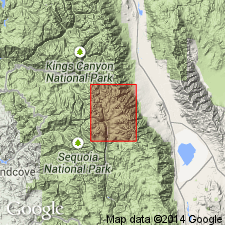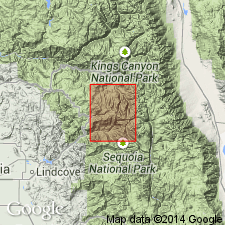
- Usage in publication:
-
- Paradise Granodiorite*
- Modifications:
-
- Named
- Geochronologic dating
- Dominant lithology:
-
- Granodiorite
- AAPG geologic province:
-
- Sierra Nevada province
Summary:
Named for exposures at its type locality on east side of Paradise Valley, east-central Marion Peak 15' quad., adjacent quad. to NW, where same rocks previously called Paradise pluton. Is part of one of largest and youngest sequences in Sierra Nevada, extending southeastward 83 km from central part of Marion Peak quad. to southeastern part of Olancha quad., and attaining width of 23 km south of Mount Whitney quad. Is composed of porphyritic granodiorite and granite (average modal analyses) with potassium feldspar phenocrysts (1-3 cm) characterized by abundant zonally arranged inclusions of biotite and hornblende. Is intruded by Whitney Granodiorite (new); intrudes Late Cretaceous granodiorite. K-Ar age of 78 Ma (biotite), 84 Ma (hornblende). Pb-U age of 86 Ma. Assigned to Late Cretaceous.
Source: GNU records (USGS DDS-6; Menlo GNULEX).

- Usage in publication:
-
- Paradise Granodiorite*
- Modifications:
-
- Revised
- AAPG geologic province:
-
- Sierra Nevada province
Summary:
Assigned as middle unit (of 3) of Mount Whitney Intrusive Suite (new).
Source: GNU records (USGS DDS-6; Menlo GNULEX).
For more information, please contact Nancy Stamm, Geologic Names Committee Secretary.
Asterisk (*) indicates published by U.S. Geological Survey authors.
"No current usage" (†) implies that a name has been abandoned or has fallen into disuse. Former usage and, if known, replacement name given in parentheses ( ).
Slash (/) indicates name conflicts with nomenclatural guidelines (CSN, 1933; ACSN, 1961, 1970; NACSN, 1983, 2005, 2021). May be explained within brackets ([ ]).

